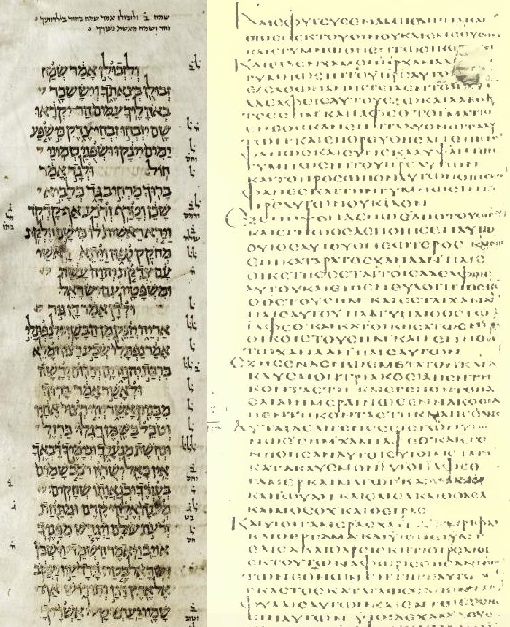Why does the Septuagint have so many differences from the Hebrew text of the Old Testament?
Over the past few years I have compared many Old Testament passages
in the Masoretic Hebrew text and the Septuagint as I have prepared to lead the
weekly lectionary study at my local Episcopal church. Sometimes there are no
striking differences, but often there are quite significant ones. Why do these
differences exist? I alluded to the reasons briefly in an earlier post. I will
now give more details.
1. The original Hebrew text had consonants but no vowels. In
modern times we are accustomed to thinking of the vowels of the Masoretic Hebrew
text as definitive. In many cases, though, different vowels are possible and
make just as much sense. Sometimes the vowels that presumably underlie the
Septuagint’s translation actually make the text easier to understand.
2. Manuscripts were handwritten. Letters could be confused
with one another, depending on the scribe’s style of handwriting. ר (r) and ד (d), ו (w) and י (y), ב (b) and כ (k) are among the
pairs of easily confused consonants. At least one of the Dead Sea scrolls has
the peculiarity that the tail on י (y) is regularly drawn longer than the tail on ו (w)!
3. There were no spaces between words. There could be
differing decisions about where one word ended and the next began.
4. Readers might accidentally or deliberately transpose
letters. Accidental transposition is common enough in any language. Deliberate
transposition can happen when the reader cannot make sense of the string of
letters as it stands. By rearranging two or more letters, and perhaps even
changing one or two, the translator was able to understand an otherwise obscure
bit of text, and he translated it into Greek according to this understanding.
5. Some Hebrew words were rare or obscure. Since scholarly
lexica had not yet been invented, translators sometimes had to use their best
judgment based on the context. As suggested in the previous point, deliberate
rearrangement of letters was another way to deal with this problem.
6. The translators were in a historical time and cultural
environment very different from that of the original writers and revisers of
the Hebrew and Aramaic scriptures. Greek-speaking Jews in Alexandria, Egypt in
200 B.C.E. had a different geographic orientation from that of Hebrew-speaking
Jews in Palestine before the exile, or Aramaic-speaking Jews in Babylon or
Persia during the exile.
We will see examples of many of these phenomena while
examining specific passages in the future.
A brief word about the Masoretic text of the Hebrew
scriptures is in order. The name of the Masoretes comes from the Hebrew word masorah
‘tradition’. The Masoretes were a group of Jewish scribes active in Israel and
Babylon in the 7th-11th centuries C.E. They lived long after Hebrew had ceased
to be a living language. They inherited traditions (thus their name) of
pronunciation and interpretation from their forbears. They devised elaborate sets
of symbols to indicate vowel sounds, intonation or melody, pauses and other
breaks in the text. They also came up with a large set of marginal notes with
corrections to the consonantal text, statistics, and so forth. (A short
introduction to these can be found in A Simplified Guide to BHS, 4th
ed., by William R. Scott; Richland Hills, TX: BIBAL Press, 1987. A more
comprehensive introduction is The Masorah of Biblia Hebraica Stuttgartensia:
Introduction and Annotated Glossary, by Page H. Kelley, Daniel S. Mynatt
and Timothy G. Crawford; Grand Rapids, MI: William B. Eerdmans, 1998.)
The first complete Masoretic manuscript of the Hebrew
Scriptures was completed in 930 C.E. by Aaron ben Moses ben Asher. This is
more than a thousand years after the Septuagint was translated, about 200
B.C.E. The Masoretic text is the basis of all published editions of the Hebrew
scriptures. Thus it underlies all modern translations of those scriptures. Consequently,
when we in modern times see the differences between the Old Testament as we
know it at the Septuagint, our first inclination may be to consider the
Septuagint to contain errors. The wiser course is to consider each version of
this text to have its own value.
If you want to dig deeper, you will need to study the field
of Old Testament textual criticism, where you will also learn about the Latin
Vulgate and the Syriac Peshitta, which also predate the Masoretic text by
centuries. A textbook of this is Old Testament Textual Criticism: A
Practical Introduction, 2nd ed., by Ellis R. Brotzman and Eric J. Tully; Grand
Rapids, MI: Baker Academic, 2016.
©
2017 Paul S. Stevenson, Ph.D.



Comments
Post a Comment